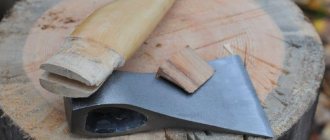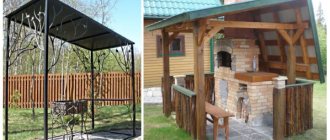More and more owners of private houses are choosing sliding gates. Production is quite a costly endeavor, so many people decide to make sliding gates with their own hands. This will also require certain costs, you will have to buy materials and figure out the availability of tools, but in the end you will get a wonderful high-quality gate at an affordable price.
It is worth considering that even independent work will cost more than another type of gate, but quality, durability and comfort are an excellent motivation to choose them. To make sliding gates with your own hands, drawings and diagrams will be very useful. You can use ready-made diagrams that you will find in this manual.
How to make sliding gates with your own hands? First of all, you need to understand the materials.
Advantages and disadvantages of this design
Advantages and disadvantages
Advantages:
- This gate design does not interfere with the exit/entry of a vehicle in a small area. Cantilever doors can significantly save space.
- The presence of the lower fastening of the console system allows you to equip the gate in any climatic conditions.
- The finishing can be made of different materials, for example, vertical lathing, corrugated board, forging and more.
- Possibility of choosing a design option, for example, from a sandwich panel or corrugated sheet.
- Compared to other types of gates (for example, swing gates), there is no such thing as sagging hinges. The existing automation and gate closing/opening mechanism provides for a long operational period.
- It is possible to choose different automation for gates.
Flaws:
- Unlike other types of gates, for example, swing gates, the installation of sliding gates requires more financial costs, approximately 10–20%.
- To attach the console part and the drive, it is necessary to make an additional foundation.
- You will need to allocate sufficient space along the fence.
Types of construction
The gate design is divided into several types, each of which differs from each other:
- Hanging. Since Soviet times, this heavy, but at the same time reliable design has gained immense popularity. In it, the canvas on roller trolleys is fixed to a beam, which is located above the passage, up to 5 m high. As a result, this height is a limitation when tall vehicles enter.
- Console. This type of gate is ideal for the climatic conditions of Russia. This design is not equipped with a beam above the driveway. Such gates will not be able to be damaged by snow drifts, wind, dust, etc. Thus, the canvas is fixed to the beam using roller carts. In this case, the entire structure is fixed on a powerful foundation, which is poured on the side of the opening.
- On screw piles. Metal piles are screwed into the ground to a depth of 1500 mm, which will support the entire structure. Their production and installation will take up to 3 days.
- Mechanical. These gates are opened/closed manually. Mechanical ones are much cheaper in cost and easier to install. They are suitable for cases where a dacha or country house is rarely used.
- Automatic. Such gates are the complete opposite of mechanical ones. They are equipped with an electric drive and remote control. The best option for regular use.
Regardless of the type of construction, sliding gates require free space along the fence on one side. In this case, it must be equal in size to the opening. As for console systems, the space should be 120–200% larger.
Varieties
There are different types of sliding gates, which are distinguished by the way the movable leaf moves:
Mechanical or rail
The sash moves along a guide (rail) laid on a solid platform. It is located at floor level so that passing equipment does not bounce on the rail and does not create unnecessary loads for it. It can be moved manually (usually this option is used for small openings) or have an automatic electric drive.
Console
This is one telescopic-type sash that does not have upper or lower guides along the width of the opening. This design is convenient in that it does not create any restrictions on the height of the vehicle or the dimensions of the cargo passing through the opening (only on the width). The most convenient, but also the most expensive design option.
Hanging
This is a design variant that resembles an inverted rail. At the top of the opening there is a powerful beam along which rollers with the sash attached to them move. The beam is closed at the top, and dust or dirt does not accumulate on it.
This design is usually used in industrial enterprises where the cargo flow through the openings is very large. The bottom rail will constantly become clogged and create congestion, which is unacceptable in production conditions.
Maksim
Builder
Owners of private houses prefer rail sliding gates - they are simpler and cheaper, and have a simple and repairable design. Suspended systems are used in production because they are inconvenient for private use - they are more difficult to repair and maintain and require lifting equipment. Cantilever sliding gates are used in organizations where there is no need for any interference in the plane of the opening. The high cost makes their use in private homes limited.
— Maxim the Builder
Gate calculation features
Features of independent calculation
Design calculation is one of the most important and priority stages. You should not ignore this stage, since the construction of sliding ones is much more complicated than swing ones.
The calculation process includes the following steps:
- Determining the height and width of the opening. As a result, it will be possible to select the required type of gate for free movement.
- Counterweight calculation.
- Estimation of the weight of the structure being constructed.
- Making a sketch or drawing.
The calculation of the width and height of the structure should be based on the market range. So, if a profile or pipe can be easily welded, then cutting sheets of corrugated board for the purpose of adding it is very difficult. Plus, the result will be unaesthetic.
Sliding gate calculations
Moreover, understanding what the final weight of the structure will be, appropriate mechanisms and moving parts are selected that can cope with the load.
If the canvas is supposed to be large, then be sure to take into account the wind load. Add a small margin to the existing wind force prevailing in your area.
Although the easiest option for obtaining calculations is to contact a specialized company that will provide a folder with drawings and calculations, you can do this yourself. It is worth immediately noting that all of the above calculations apply to cantilever-type sliding gates. They are more complex than all other types, so let’s look at them in more detail.
Sliding gate device
This type of gate has the following structural elements:
- Guide beam. Takes on all their weight.
- Trolley or roller support. You need 2 of them.
- Removable end roller. When closed, it serves as a support.
- Upper/lower catcher. When the gate is closed, the lower one takes the load, and the upper one reduces the windage.
- Bracket. It is important for keeping the sash from swinging sideways.
- Stand. A support is installed on it, which organizes the movement of the sash.
Roller supports are installed on the foundation, which take on the load of the guide beam. The rollers are placed inside the supporting console.
Rail
In this system, the rollers, on the contrary, are welded to the bottom of the door leaf. The gate moves thanks to rollers along a rail installed at the zero level (the roller is “recessed” into the passage). The rail does not obstruct the passage of cars at all.
Pros:
- Impact resistance.
- Possibility of installation in wide (for example, 6 meters) openings.
- Thanks to the support in the form of rollers, the canvas does not sag.
- The canvas is compact. The space occupied by it is equal to the opening in width.
Of the minuses:
- The operation of the rail may be blocked because the rail may become clogged with debris, sand, sediment or any small objects. You must be prepared for the fact that in winter, during periods of frequent temperature changes, the snow may melt and water will form in the rail, which will subsequently freeze and block operation.
- The rail requires regular cleaning.
Sash selection
Sliding gate leaf
The gate leaf is also subject to high demands. Its design must be sufficiently rigid and stable. This is important so that in the event of a strong gust of wind or ice, the sash functions well. Moreover, it must be equipped with additional stiffening ribs so that it does not sag under its own weight. All this should be taken into account when creating drawings.
Selection of components
The availability of certain components directly depends on the height and width of the sash, as well as its weight. So, today on the market you can find a number of companies that provide high-quality equipment, namely:
- Combi Arialdo and Flatelli Comunello from Italy.
- Roltek and Doorhan from Russia.
- Alutech from Belarus.
Installation work
Installation of sliding gates
The movement of the door leaf should be carried out from the inside of the site, namely along the fence. Based on this, it is necessary to prepare a place for the gate so that absolutely nothing interferes with this process.
The installation process includes 4 steps:
- Making the foundation.
- Electrical wiring.
- Installation of a response pole.
- Automation installation.
Making the foundation
Stages of foundation construction:
- First, marking is carried out. Measure 500 mm from the fence (the width of the foundation). You also measure from the edge of the gate a distance equal to the rollback (the length of the foundation). So, you will see the perimeter of the future foundation.
- It is often possible to use fence support posts. If this is not possible, then a counter post should be installed on the opposite side. It must be installed so that it is inside the area, and not in the opening itself. Otherwise, it will reduce the width of the opening.
- If the gate will operate automatically, then be sure to organize a place for laying the wiring. To do this, you can use a square metal or plastic pipe/box. The diameter of the pipes is not less than 25 mm.
- Now you can start digging a pit. The depth of the trench is up to 2 m, below the soil freezing level (different in each region).
- To make the embedded element, you can use channel 16. Its length should correspond to the length of the trench. Reinforcement Ø12 mm is laid in the foundation. The reinforcement must be welded to the channel and connected with cross braces.
- Thus, the resulting embedded element is placed with the reinforcement down. When laying, make sure that the side of the channel is adjacent to the fence support post. Also, the channel must be set strictly level and exactly parallel to the gate opening line.
The embedded element must be flush with the road surface. The minimum gap allowed between the bottom edge of the gate and the road is 10 cm. This gap can be increased using an adjustment platform. But it will be impossible to reduce this gap without breaking the fastenings.
Installation of the embedded element
If for one reason or another a gap of 100 mm is not suitable, then install the embedded element deeply.
As for concrete work, it is carried out when the installation of the embedded element is completely completed. The concrete level should be flush with the embedded element.
Installation
Gate installation
When the foundation has hardened, you can begin to install the gate. To do this, you first need to make markings. Along the line of the opening, not reaching the counter post 30 mm, pull the cord. This cord is the gate's movement path. The height of the cord tension is 200 mm. Further work looks like this:
- Determine the extreme position of the first and second roller support. From the edge of the opening, step back 15 cm along the plane of the embedded element and draw a line for the position of the outermost first trolley. Calculate the line of the second cart as follows: measure the entire length of the gate with the cantilever part and subtract 10 cm from the edge of the return post along the plane of the embedded element. As a result, you will determine the location of the second cart.
- Now insert the roller supports into the supporting profile, placing them in the center.
Afterwards it is necessary to weld the second trolley of the adjustment platform. Then roll the gate leaf into the opening and make final position adjustments. Make small tack welds by welding the second adjustment pad, the resulting action looks like this:
- Remove the canvas from the roller cart.
- Next, remove the carts from the platforms.
- Weld the platforms to the embedded element.
- Attach roller carts to them.
- Slide the canvas onto the roller supports.
- Close the gate and use a wrench to adjust its position.
Coloring
Painting the gate
All metal elements of the gate must be painted. Pre-degrease the surface. To do this, clean the surface and sand it with a sanding disc on a grinder. Wipe some areas, such as protected areas, with acetone. Now you can start priming. It is applied evenly. Moreover, the primer must be applied so that there are no drops or streaks. Thanks to such preparatory work, the paint will lie evenly. As a result, the entire gate structure will be completely protected from corrosion.
The paint should be applied in two layers and only after the first has completely dried.
Video description
The video shows how to install sliding gates with your own hands, step by step:
At this point, we can assume that the answer to the question of how to make sliding gates has been given in full. Of course, there are many additional nuances that you need to pay attention to. But, as practice shows, each master with extensive experience has his own approach to the implementation of the task. Therefore, anyone who solves the problem of how to make sliding gates with their own hands must understand that the quality of the final result is experience in carrying out construction operations of this type, plus skills in working with tools: an electric welding machine, an angle grinder, and others.
Height-adjustable carriage
Necessary tools for work
To carry out all the work, you will need to have the following tool:
- Inverter welding material. Such a unit will not damage the metal.
- Bulgarian.
- Air compressor for painting.
- Pliers.
- Drill.
- Roulette.
- Level.
- Riveter.
Common Mistakes
If you do not have sufficient experience in performing such work, then there is a high risk of making some mistakes:
- Insufficient foundation preparation.
- Incorrect installation and fastening of all components.
- Incorrect weight of the gate for the load-bearing beam.
- If you hear a creaking sound, this is evidence of sand getting into the bearings.
- Do not allow paint to drip.
- Be sure to take into account the depth of soil freezing. Otherwise, the pillars may skew in one direction.
Original finishing methods
Antique wooden gates are one of the popular types of decoration. There is a huge variety of options offered, where many people prefer carved gates.
This type of finishing is complicated. To carve even the simplest figures from wood, you need special tools with the skills to work with them, experience and imagination. If neither one nor the other is available, then it is better to order a ready-made trim, which you can attach to the frame of the doors yourself. Hand cutting is expensive.
Advice! Stores sell carved elements made from thin boards or thick plywood, which you simply need to nail with small nails to the elements of wooden gate leaves.
To make it look antique, you can use painting. It also requires imagination and the ability to paint, although you can do without it. You need to buy stencils, since a wide range is sold in art stores. They can even be ordered for a specific design. And already applying painting through a stencil is a simple matter.
Another option for antique fitting is forged elements. This finish is the height of respectability. Even the most inconspicuous wooden gates, lined with forging, become a masterpiece of art. It is impossible to forge iron with your own hands if you are not a specialist in this matter. Fortunately, forged elements are sold in construction stores today. They are attached to wooden gates with nails or self-tapping screws.
Photo: options for finished sliding gates
Automatic wrought iron gates
Sliding gate automation
Wooden sliding gates
Forged
Beautiful gate design
Mechanical
Metal
Sliding gates at the dacha
With automatic
With built-in gate
View from the yard
Street sliding gates
Protecting wood from environmental influences
A wooden sliding door will last a long time if additional protection is applied to it. The impregnation should be suitable for outdoor work and be oil-based only. It is best to use septic tanks that have a combined effect; such products protect from both moisture and the sun. And from harmful insects.
It is recommended to use glaze or yacht varnish as a finishing coat. For more complete protection, you can use these two products together, first apply the glaze, and only then the varnish.
It must be remembered that the validity period of any protective agent does not exceed six years, which means that after the specified period, the treatment will need to be repeated to maintain the proper level of protection of the material.
Scheme
In the diagrams you can find many structural details for the manufacture of sliding gates:
4 meter gate drawing
Design
Methods for fastening sliding gates
Assembly drawing
Diagram of sliding gates and openings
Equipment
Gate base
Preparing the opening
Construction scheme
Installation of columns
Mortgage installation diagram
Did the article help you?
Service
If manual opening sliding gates were made, that is, without automation and a drive, then periodic maintenance comes down to eliminating areas of metal corrosion and lubrication of rotating parts - rollers. These procedures will extend the life of the gate and ensure its smooth operation without distortion.
If an electric drive is added to the design, the number of preventive measures increases:
- cleaning the rack and gear from dirt;
- cleaning photocells and limit switches;
- voltage check.
Do not lubricate the rack and gear; they will quickly become covered with dirt.











